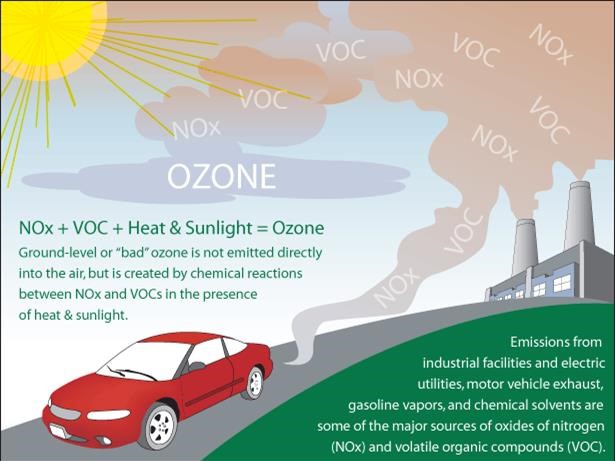Ground-level Ozone Basics
- What is "good" vs. "bad" ozone?
- How does ground-level ozone form?
- What are the harmful effects of ozone?
- What is being done to reduce ozone pollution?
Ozone is a gas composed of three atoms of oxygen. Ozone occurs both in the Earth's upper atmosphere and at ground level. Ozone can be good or bad, depending on where it is found.
Called stratospheric ozone, good ozone occurs naturally in the upper atmosphere, where it forms a protective layer that shields us from the sun's harmful ultraviolet rays. This beneficial ozone has been partially destroyed by manmade chemicals, causing what is sometimes called a "hole in the ozone." The good news is, this hole is diminishing. Learn more about stratospheric, or "good" ozone.
Ozone at ground level is a harmful air pollutant, because of its effects on people and the environment, and it is the main ingredient in “smog." Learn more about air emission sources.
How does ground-level ozone form?
Tropospheric, or ground level ozone, is not emitted directly into the air, but is created by chemical reactions between oxides of nitrogen (NOx) and volatile organic compounds (VOC). This happens when pollutants emitted by cars, power plants, industrial boilers, refineries, chemical plants, and other sources chemically react in the presence of sunlight.
Ozone is most likely to reach unhealthy levels on hot sunny days in urban environments, but can still reach high levels during colder months. Ozone can also be transported long distances by wind, so even rural areas can experience high ozone levels.

What are the harmful effects of ozone?
What are the health effects of ozone?
Ozone in the air we breathe can harm our health, especially on hot sunny days when ozone can reach unhealthy levels. People at greatest risk of harm from breathing air containing ozone include people with asthma. Learn more about health effects.
What are the environmental effects of ozone?
Elevated exposures to ozone can affect sensitive vegetation and ecosystems, including forests, parks, wildlife refuges and wilderness areas. In particular, ozone can harm sensitive vegetation during the growing season. Learn more about how ozone harms ecosystems.
What are the ozone levels in my community?
Air quality forecasts are often given with weather forecasts on handheld devices, online or in the paper or television. You can check ozone levels and other daily air quality information by visiting www.airnow.gov and in many areas you can receive air quality notifications through www.enviroflash.info.
What can I do to reduce ozone?
There are actions every one of us can take to reduce air pollution and keep the air cleaner and precautionary measures you can take to protect your health. Visit AIRNow for tips on what you can do.
What is being done to reduce ozone pollution?
How is ozone pollution controlled?
Ozone is one of the six common air pollutants identified in the Clean Air Act. EPA calls these “criteria air pollutants” because their levels in outdoor air need to be limited based on health criteria.
There are national ambient air quality standards (NAAQS) for each of the criteria pollutants. These standards apply to the concentration of a pollutant in outdoor air. Learn more about criteria air pollutants and NAAQS.
After working with the states and tribes and considering the information from air quality monitors, EPA "designates" an area as attainment or nonattainment with national ambient air quality standards. If the air quality in a geographic area meets or does better than the national standard, it is called an attainment area; areas that don't meet the national standard are called nonattainment areas. Learn more about ozone air quality designations.
In order to improve air quality, states must draft a plan known as a state implementation plan (SIP) to improve the air quality in nonattainment areas. The plan outlines the measures that the state will take in order to improve air quality. Once a nonattainment area meets the standards, EPA will designate the area as a "maintenance area."
What rules or regulations help reduce ozone pollution?
EPA’s national and regional rules to reduce emissions of pollutants that form ground level ozone will help state and local governments meet the Agency’s national air quality standards. Actions include vehicle and transportation standards, regional haze and visibility rules, and regular reviews of the NAAQS. Learn more about ozone standards.
